A Complete Guide on Iran Tours for Muslim Travelers
As a Muslim traveler, finding a destination that caters to your needs and religious beliefs can be a challenge. However, with rich Islamic history and heritage, IRAN is a country that stands out when it comes to Muslim-friendly holidays. The country has many Islamic attractions that are of great interest to Muslim travelers. These include historical sites, mosques, shrines, and museums that showcase Islamic art and architecture. The city of Mashhad is especially famous for its prominent shrines, including the shrine of Imam Reza (AS), which is one of the most sacred places for Shia Muslims. From its rich cultural heritage to its delicious halal food, IRAN offers a memorable experience and hassle-free Iran tours for Muslim travelers. In this guide, we will explore the best of Iran, including cultural sites, halal cuisine, accommodations, and travel tips.
Why Iran Is a Perfect Destination for Your Muslim-Friendly Holidays
Iran is a beautiful and culturally rich country that offers many opportunities on Iran tours for Muslim travelers. As a predominantly Muslim country, Iran offers a variety of mosques and other Islamic sites for visitors to explore, as well as halal food options. Some of them are also inscribed on the UNESCO Heritage List, such as the Imam Mosque in Isfahan.
Many Muslim Countries Nationalities Do NOT Need Visas for Travel to Iran
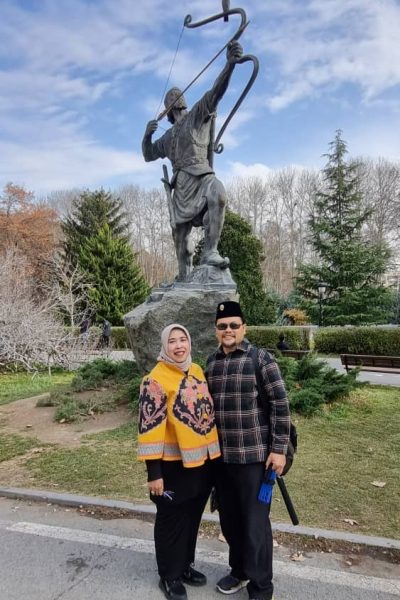
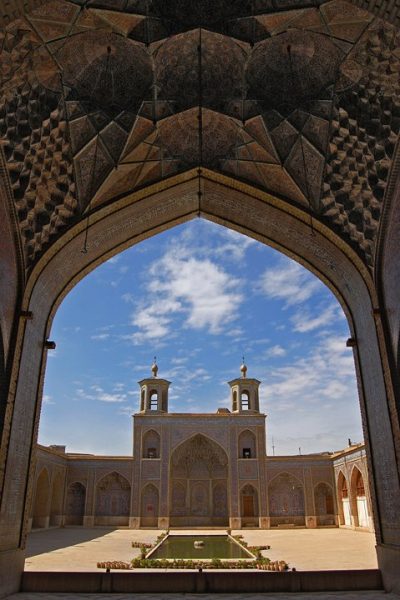
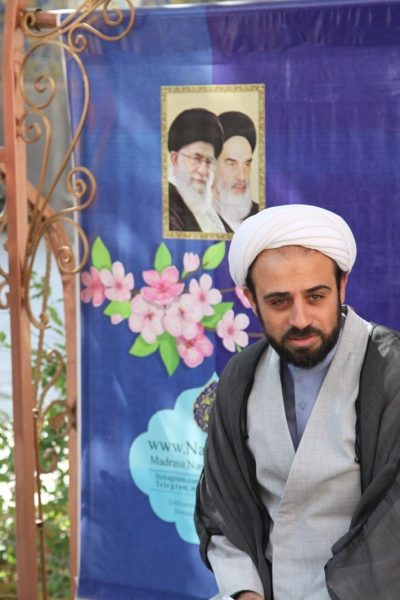
Visiting Islamic Sites in Iran
Iran is home to many important Islamic cultural sites. These magnificent sites make Iran tours for Muslim travelers a must-visit. Here are some of the top cultural sites for Muslims to visit in Iran:
The Imam Reza Holy Shrine in Mashhad
The Imam Reza Shrine, located in the city of Mashhad in northeastern Iran, is one of the most important religious sites in the country. It is the final resting place of Imam Reza, the eighth Shia Imam, and is visited by millions of pilgrims every year.
The Imam Reza Shrine is a complex of buildings that includes courtyards, halls, and shrines. The main entrance to the shrine is through the southern gate, which leads to the first courtyard. From there, visitors can enter the main building, which houses the tomb of Imam Reza. The architecture of the Imam Reza Shrine is a blend of traditional Iranian and Islamic styles. The main building is covered with glazed tilework and decorated with intricate calligraphy. The dome of the shrine is adorned with a golden globe and crescent, and the walls are adorned with inscriptions from the Quran.
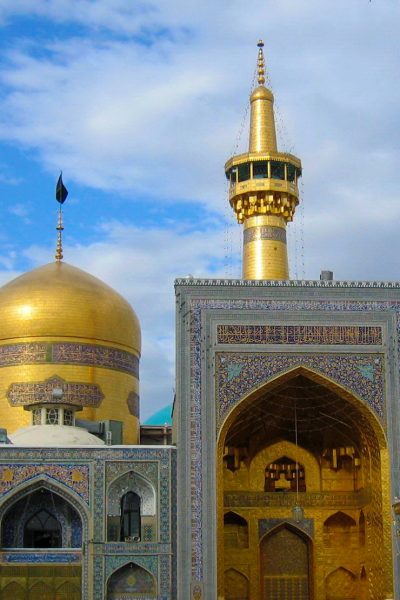
The Museums in the Shrine:
In addition to the tomb of Imam Reza, the shrine complex also houses several museums that showcase the history and culture of the region. These museums feature a wide range of exhibits, including:
- Museum of Quoran and Exquisite Quoranic Objects
- Museum of Ali Khamenei Endorsements (the supreme leader of Iran)
- Museum of Holy Shrine History
- The Hall of Master Farshchian Artworks
- The Carpet Museum
- Anthropology Museum
- The Treasury of Stamps and Postal Items
- The Treasury of Paper Money
- The Treasury of Coins
- The Treasury of Abstract Arts
- The Treasury of Aquatic Creatures
- The Treasury of Astronomy
- The Treasury of Clocks
- The Treasury of Utensils
- The Treasury of Weapons
- The Treasury of Medals
The Imam Reza Holy Shrine is not only a place of pilgrimage for Shia Muslims but also a center of religious and cultural ceremonies. One of the most important ceremonies that take place at the shrine is the annual mourning ceremony of Muharram. This ceremony marks the martyrdom of Imam Husayn, the grandson of Prophet Muhammad, and is one of the most important events in the Shia calendar. During the ceremony, large crowds of people gather at the shrine to participate in the processions, mourning gatherings, and self-flagellation rituals, which are considered a way to express their grief and devotion to the Imam.
Another important ceremony is the Ghamari ceremony, which is held on the first day of the Iranian year. This ceremony marks the birthday of the 8th Shia Imam, Ali al-Ridha, and is celebrated with special rituals, including the recitation of prayers, the distribution of sweets, and the lighting of candles.
Additionally, there are daily ceremonies and rituals held at the shrine, including the recitation of the Quran, the performance of traditional music, and the distribution of food and drinks to visitors. The magnificent Imam Reza Holy Shrine is often included on Iran tours for Muslim travelers.
Shrine of Fatima Masumeh in Qom
The Shrine of Fatima Masumeh is located in Qom, which is considered by Shia Muslims to be the second most sacred city in Iran after Mashhad. Fatima Masumeh was Imam Reza’s sister and the daughter of the Imam Musa al-Kadhim (the seventh Imam). In Shia Islam, women are often revered as saints if they are close relatives to one of the Twelve Imams. Fatima Masumeh is therefore honored as a saint, and her shrine in Qom is considered one of the most significant Shi’i shrines in Iran. Every year, thousands of Shi’i Muslims travel to Qom to honor Fatima Masumeh and ask her for blessings. Also buried within the shrine are three daughters of the ninth Twelver Shī‘ah Imām Muhammad al-Taqī. The mosque consists of a burial chamber, three courtyards, and three large prayer halls, totaling an area of 38,000 m2 (410,000 sq ft). The three prayer halls are named: Tabātabā’ī, Bālā Sar, and A‘dham. Though Shi’i theology formally states that the relatives of the Imams, or Imamzadehs, hold a lower status than the Imams, popular Shi’ism still strongly venerates Imamzadehs. In Iran, there are many more burial places for the Imams’ relatives than there are for the Imams themselves. Imamzadehs are considered to be close to God and religiously pious because of their close relation to Imams. Shi’is commonly travel on pilgrimages to shrines of Imamzadehs, such as the Shrine of Fatima Masumeh, the sister of the 8th Imam ‘Ali al-Rida, in Qom. Men and women seek cures for ailments, solutions to problems, and forgiveness of sins at these sites. Many hadiths, or teachings, are recorded from Shi’i Imams praising the veneration of Fatima Masumeh, and proclaiming that those who make a pilgrimage to her Shrine will “certainly be admitted to heaven.”
Fatima Masumeh died in Qom in 201 A.H. as she traveled to join her brother, Imam Ali al-Rida in Khorasan. The caravan she traveled in was attacked in Saveh by enemies of the Shi’is, and 23 of Fatima Masumeh’s family and friends were killed (Jaffer). Fatima Masumeh was then poisoned by a woman from the enemies, fell ill, and asked to be taken to Qom, where she died. Fatima Masumeh’s host in Qom buried her in his plot of land.
The style of Fatima Masumeh’s Shrine has developed over centuries. At first, her tomb was covered with a bamboo canopy. Fifty years later, this was replaced by a more durable domed building, at the request of the daughter of Imam Muhammad al-Taqī, Sayyida Zaynab. The family of Sayyida Zainab later added a further two domes to the Shrine. These architectural projects marked the beginning of female patronage of the tomb of Fatima Masumeh.
In 1519, Tajlu Khanum, the wife of Shah Isma’il I, led a project to improve the drainage around the Shrine, embellish the Shrine with an iwan and two minarets, and reconstruct the tomb chamber as a domed octagon. During the Safavid dynasty, the women of this family were very active in embellishing the Shrine of Fatima Masumeh. In times of war, Safavid royal women found refuge in Qom and likely compared their situation to that of Fatima Masumeh. These women donated beautiful fabrics and other items to the Shrine. Shah Abbas I of the Safavids did not patronize the Shrine of Fatima Masumeh as much as he did other shrines of Imams, but he did offer books to the Shrine’s seminary library. Over the years, many Safavids of royal birth were buried close to the Shrine of Fatima Masumeh.
From 1795-1796, Fath-Ali Shah Qajar converted two Safavid Sahn or courtyards into one large courtyard and, in 1803, fixed the golden dome. In 1883, Amin al-Sultan added the new sahn e-jadid or “New Court” to the Shrine complex.
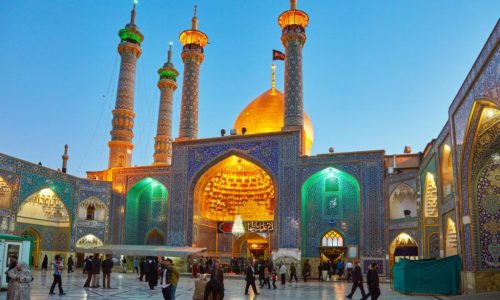
Shah Cheraq Mausoleum in Shiraz
Mir Seyyed Ahmad is the main shrine mausoleum in Shiraz. He is the son of the Seventh Imam, Mosa Kazem (AS), known as Shah-e-Cheragh. It is located near a new mosque in Shiraz.
Seyyed Mir Ahmad, between the years 1434 to 1435 BC and during the reign of Mamoon, decided to leave Fars and Shiraz towards Khorasan to visit his brother Imam Reza. But he was killed and Buried in Shiraz. The Third respectable pilgrimage destination In Iran is Shah-e-Cheragh, After the shrines of Imam Reza in Mashhad and Fatima Masoumeh in Qom.
The shrine has the Shirazi structure as a bulbous dome. It is decorated with mirrorwork and four slender wooden pillars that boast near-perfect proportions. There is a main Porch in the east and a large shrine on four sides. There is also a mosque, as well as several rooms and sepulchers on the west of the shrine, which is connected to the monument. The design of the mausoleum has mirror works, ornaments, silver doors, and porches. Also plaster writings, and a spacious sanctuary. In alcoves between the areas under the dome of the shrine, the sanctuary is located. This construction method and shrine in the middle of the mausoleum are the same as the other shrines in Shiraz.
Shah-e-Cheragh is one of the popular tourist destinations in Iran, and all like it because of its spiritual atmosphere and the mirror work inside the mausoleum.
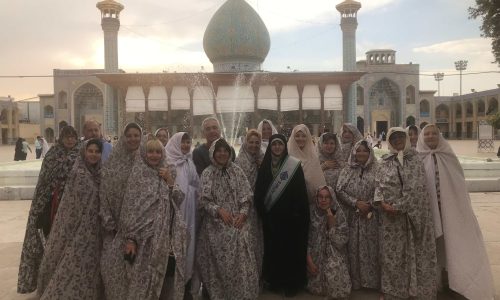
National Museum of Iran in Tehran – Museum of Islamic Arts
The Museum of Islamic Arts is like an octagon or a cruciform with a stone façade. It is a place for keeping post-Islamic artwork. In this section of the National Museum of Iran in Tehran, all kinds of Islamic art are exhibited on 2 floors and 6 separate halls. These artifacts include calligraphy, gilding, tiling, and altar-making.
To visit the museum, you must first start from the second floor and then go to the first floor. The halls of Early Islam, Seljuk, and Ilkhani are on the second floor. The halls of Quran, Timurid, Safavid, Afshar, Zand, and Qajar are on the first floor.
In the Early Islam hall, you will see that calligraphy became very popular in this era. Thus, Qurans which are written on deer skin, are one of the most important works of this era. Pottery, glassmaking, enameling (painting on glaze), metal objects with silversmithing and goldsmithing, and latticework shown in the museum are likewise among the best arts of the Seljuk era.
Ilkhanids dominated Iran after the Mongol invasion and also after a long period of inactivity in art. You can see beautiful artifacts of this era in the Tehran National Museum of Iran. They include metalwork, silversmithing, goldsmithing, bronze objects, latticed pottery, enameled pottery, and gold-plated pottery. The Safavid era was a flourishing period for Islamic art. Calligraphy was the art that became popular in the Safavid era. You can also see this lasting art in exquisite Qurans which are displayed in the museum. Oil paintings, calligraphy on cloth, the art of carpet weaving, and also seven-color tiles are some of the amazing works of this era in the museum.
The last hall of the Islamic Museum is the Quran Hall. This hall is located in a space under the central dome and on the first floor of the museum. This hall embraces many exquisite Qurans. One of the most beautiful works in this hall is a page of an exquisite large Quran. Located in the center of the hall, it is said that Nader Shah, a king of the Afshar era, carried this Quran with him during the war.
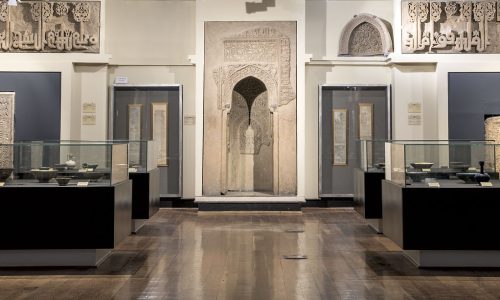
National Museum of Holy Quran museum in Tehran
This museum has been built in a space with a 10,000 square meter area in which three main sectors of the Museum, administration, and specific library are recognizable.
All the construction is placed underground at 14 meters depth. In addition to the Quran manuscripts related to a vast timespan, from the 4th century AH to the late Qajar period, this museum also narrates the development process of other related arts to the writing of the Quran, including gilding, bookbinding, calligraphy, etc.
The museum exhibits are displayed in three parts as follows: 1. the cultural-historical section; 2. the section on Quranic objects; and 3. the section on contemporary works of art. A collection of manuscripts and lithographic Qurans, the poets’ books, scrolls, prayer books, and Quranic pieces are on display in the first sector of the museum.
Works of famous artists, such as Mir Ali Heravi, Mohammad Ibrahim Qomi, Abdol Gader Hosseini, and Om-e Salameh are also kept here. The second part contains objects like wares, vases, boxes, pencil cases, and coins on which the Quranic verses or prayers are somehow included.
The third part has been devoted to the works of contemporary artists, especially the painters and calligraphers whose paintings, calligraphy, and calligram works are kept in the museum. At present, the museum embraces 650 granted Quranic works.
Besides the objects, the internal architecture of the museum and its decorations cannot be overlooked; it is inspired by the Iranian-Islamic style of architecture where a part of the motif of Shamseh (the sun) has been depicted in each of the three stories of the museum.
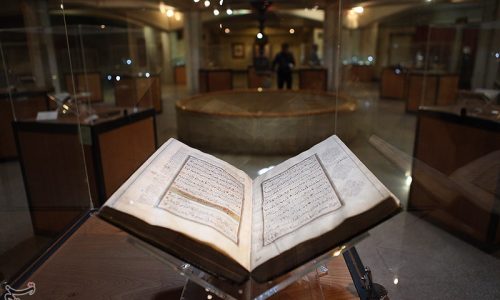
Imam Zadeh Saleh in Tehran
Iran tours for Muslim travelers can be an exciting opportunity for both visiting religious sites and shopping. Imamzadeh Saleh is one of Imam Musa al-Kadhim’s sons, the seventh Shiite Imam, whose shrine is located on Tajrish Square in the northern part of Tehran called Shemiran. Imamzadeh Saleh Shrine is one of the oldest and most famous shrines in Tehran that is visited by many people every day. According to the old inscriptions, the origin of its construction dates back to the early 13th century. The main structure includes a large rectangular building with thick walls and spacious interior space. The Iwan is lined with Quranic calligraphies and delicate colorful tiles. There are two-story arcades on both sides of the Iwan followed by two tall minarets, and the dome is situated right behind the Iwan. There is a wooden box in the interior space that probably has been left from the late Safavid or Afsharid dynasties. The shrine was destroyed during the Mongol invasion of Ray around 1238 and was reconstructed and restored in the year 1321 during the Ilkhanids period. Right next to this holy shrine, lies the pretty little Bazaar of Tajrish where you can breathe in the traditional fabric of the structure in which different types of stores are attached. Many of them are calling your attention to fresh fruits and vegetables, while others try to sell you the best Persian handicrafts and souvenirs.
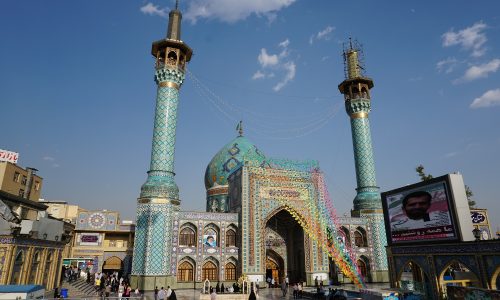
Jamkaran Mosque in Qom
The city of Qom is known as one of the most important religious centers among the followers of Shiites in Islam. It hosts two magnificent pilgrimage sites called Fatima Masumeh Shrine and the Holy Jamkaran Mosque. This mosque is not only important because of its religious value but also because of its rich historical and architectural background. Many pilgrims prefer to visit this mosque on Tuesday nights; so, if you go to Jamkaran Mosque in Qom at that time, you would see many people praying and saying prayers on every corner and this makes a wonderful relaxing spiritual atmosphere. A big blue dome in the middle has four smaller green domes on both sides and two tall minarets all decorated with magnificent tile works that amaze the eyes at first glance. The big yard in the front covered with pure white stone signifies the purity and innocence of Jamkaran Mosque in Qom.
These are just a few examples of the many Islamic sites that Iran has to offer. Muslim travelers should also consider visiting smaller, lesser-known mosques and Islamic sites for a more authentic experience. It is always a good idea to check the opening hours and dress code before visiting these places.

When to Visit Iran
Apart from the summer months which are hot in Iran, you can travel the whole year.
Iranian Halal Cuisine
The origins of Persian cuisine are a bit complex – due to the Iranian history of over 2,000 years. The Persian Empire once stretched from India to Greece, since then, Iranian cuisine has been influenced by various nations throughout the vast empire. Neighbors such as Greeks, Romans, Arabs, Russians, and Turks also influenced it.
Iranian cuisine is a rich and diverse culinary tradition shaped by centuries of history, culture, and geography. With its unique blend of flavors, spices, and ingredients, Iranian food truly reflects the country’s rich cultural heritage.
Iranian cuisine is a feast for the senses, from the aromatic saffron rice dishes to the succulent kebabs and stews. The use of fresh herbs, fruits, and vegetables, along with various meats and grains, makes Iranian food healthy and delicious.
As per Islamic dietary laws, all Iranian food is halal with the use of halal meat, which is meat that has been slaughtered according to Islamic guidelines. Many Iranian dishes, such as kebabs, stews, and rice dishes, can be made with halal ingredients and prepared in a halal manner. Moreover, alcoholic drinks are banned in Iran according to Islamic laws. Halal food, or better to say Halal tourism, makes Iran tours for Muslim travelers the top choice.
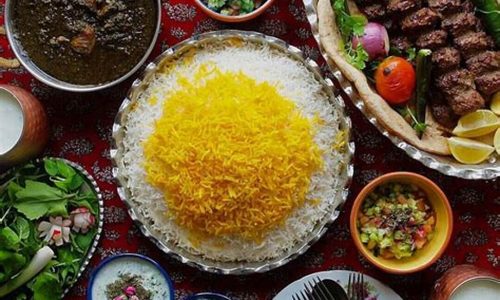
Muslim-friendly Accommodations in Iran
Iran tours for Muslim travelers are not only limited to the religious sites and Halal food. Iran offers a variety of Muslim-friendly accommodations, including hotels, guesthouses, and villas. All hotels offer prayer facilities and halal food options, as well as easy access to cultural sites and attractions.
Halal tourism in Iran also benefits from the availability of halal hotels. Many hotels in Iran cater to halal tourism and provide separate facilities for men and women. For instance, hotels offer separate swimming pools or beach areas for males and females, ensuring families can enjoy their vacations within Islamic guidelines. Women-friendly airports, hospitals, and parks are also in the pipeline that can boost the overall scope of halal tourism in the Islamic Republic.
Iran tours for Muslim travelers could be the best option due to the Muslim-friendly cuisine, accommodation, and facilities.
Plan Your Prayer Times
Another prospect for halal tourism in Iran is the availability of prayer facilities. Mosques are available everywhere, and travelers can easily find a clean and quiet place to pray, regardless of where they are.
Iran has many mosques and prayer facilities, but it is still important to plan your prayer times in advance. Many hotels offer prayer facilities, such as prayer mats for their guests but if you are out exploring the city, be sure to find a mosque or quiet place to pray.

Traveling to Iran during Ramadan
One way of getting cheaper hotels and flights is by visiting Iran during Ramadan. This may be a good time to visit IRAN if you want to experience the Ramadan atmosphere but keep in mind that it might be harder to find food during the fasting hours. It can also get very difficult traveling in Ramadan due to heat or when going with kids. With thousands of mosques spread across the city, you can hear the beautiful ‘Adhan’ (call to prayer) throughout the day.
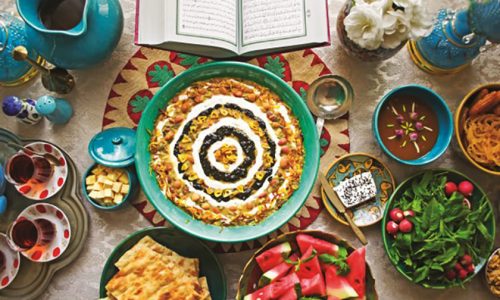
Traveling to Iran during Muharram and Ashura
One of the unique times to travel to Iran is during the lunar month of Muharram, because Shia Muslims in Iran have special ceremonies during this month, especially the first 10 days. The tenth day of Muharram is called “Ashura” (the first and one of the sacred months of the traditional Islamic lunar calendar) in which Hussayn Ibn Ali and his followers were martyred by Yazid’s army in the battle of Karbala. The day of Ashura will be on the evening of the 7th of July and end on the evening of the 16th of July, 2024. Shia Muslims believe that the death of Hussayn and his family in Ashura shows people the value of standing for what you think is right. In the battle of Karbala, Yazid’s armies surrounded Imam Hussayn and his family for days, stopping the flow of water near their camp. They could not even get fresh water and had to survive with all they had for several days, but they stood against injustice and showed the value of truth. It is significant for Shia Muslims to cherish Muharram, especially this day, and practice having more spirituality and morality in life.
On this day, Muslims of Iran mourn the death of Imam Hussayn by singing Noha, which is a type of lament and chest-beating to show their grief. Moreover, in every part of Iran, people perform a type of historic Persian opera or play called Ta’zieh. If you travel to Iran during Muharram, you can see Tazieh, in some streets, the play or ‘Tazieh’ is performed re-enacting the battle of Karbala and the suffering of Imam Hossain and his supporters at the hands of Yazid. Yazid and his troops are presented wearing red and the descendants of the prophet are in green.
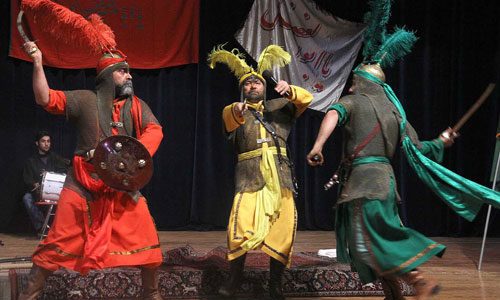
There is also another type of commemoration in Iran during Muharram. People prepare food (called “Nazri” by Iranians) and distribute it for free among their neighbors, in front of their doors, in mosques, and also among people passing the streets. They believe that by feeding people, especially mourners, and slaking their thirst, in the name of Imam Hussain and for the sake of Allah, they will have blessings and divine rewards.

Nakhl Gardani is another Shia religious ritual carried out on the day of Ashura to commemorate the death of Husayn ibn Ali, the grandson of the Prophet Moḥammad and the third Shia Imam. Nakhl is a wooden structure used as a symbolic representation of the Imam’s coffin and Nakhl Gardani is the act of carrying the Nakhl from one place to another, resembling an Imam’s funeral. The Nakhl-Gardani ceremony is mostly held in Yazd city.
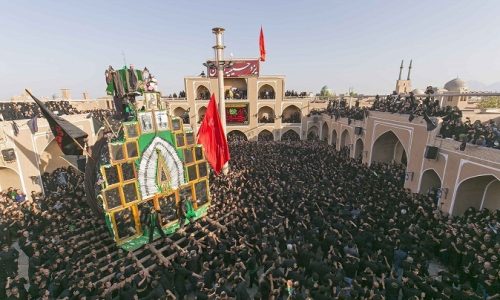
When is Arbaeen?
Arbaeen is observed on Safar 20th or 21st, the 40th day after Ashura. Arbaeen means forty in Arabic as forty days is the traditional length of mourning after the death of Imam Hussein in 680 AD. Millions of pilgrims will gather in Karbala on Arbaeen, making it the world’s largest annual human gathering. Making the pilgrimage, known in Arabic as the Ziara, many of the pilgrims travel barefooted from across Iraq and more than 50 countries. Over three million Iranians travel to Iraq for the Ziara.
In Iran, thousands of people who cannot travel to Iraq march in different cities.
Thetis Persia Travel Agency offers Iran tours for Muslim travelers including a wide range of services, such as halal accommodations, halal food options, and prayer facilities. When you travel with us, you can be sure that your travel needs will be met and that you will have an unforgettable experience in Iran. Iran is a Muslim-friendly holiday country that offers a unique and unforgettable experience for Muslim travelers. From its rich cultural heritage to its delicious halal cuisine, Iran has something for everyone. Start planning your Muslim-friendly holiday to Iran today!
